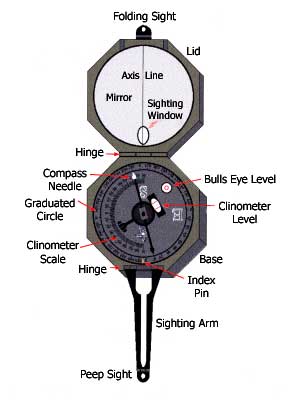
The Brunton Pocket Transit that all geologists know as the 'Brunton' was invented in 1894 by D. W. Brunton, a Canadian mining geologist. It has been in use for more than a hundred years and is still being manufactured. The mark of a field geologist is the belt-mounted small leather case where the Brunton is carried. An octagonal box of machined aluminum holds a clamped compass needle and clinometer, both provided with bubble levels and measuring scales marked in degrees. the inner surface of the lid is a mirror. That allows the observer to see both a distant point and the compass face at the same time.
In Arabia this feature was little used, for most of the time in choosing the direction of a traverse the Brunton was mounted on a tripod and carefully leveled with the peep and folding sights aligned on the feature intended to serve as an aiming point. Its direction read, the automobile followed that compass course as closely as possible. But the mirror of the Brunton served to signal aeroplanes in search of a landing strip and to catch the attention of someone at a distance. the bright point and the flickering across the face invariably got attention.
The clinometer was seldom used because the 'dip' (maximum inclination from the horizontal) of the stratum being studied was almost always very low, commonly less than a degree, so that determining strike (the trend of a structural surface [e.g. bedding plane] as it intersects the horizontal) was not feasible using the four-inch case of the Brunton as a guide. So dip and strike were commonly measured using the theodolite or alidade and a stadia rod sited at the point of maximum inclination of a bedding plane. This the dip, is always at 90o to the strike measured on a horizontal plane.